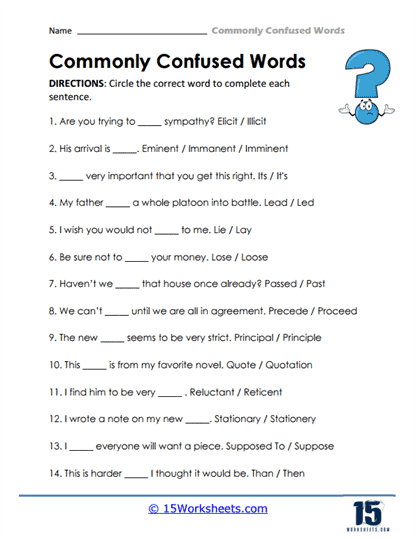

This series of 15 worksheets is designed to help students learn and practice commonly confused words in the English language. These exercises aim to reinforce students’ understanding of the differences between words that are similar in spelling or pronunciation, but have different meanings. Through these worksheets, students will:
Overall, these worksheets provide a variety of exercises to help students learn and practice commonly confused words. By completing these exercises, students can improve their vocabulary, writing, grammar, and critical thinking skills, while also gaining a deeper understanding of the nuances of the English language.
There is a whole array of commonly confused words in the English language. Some words sound similar, while others look similar. However, these commonly confused words are incredibly different in their meaning. It is essential to go through these words and the context in which they are used so that you can practice using them smoothly without making any significant mistakes or blunders in writing or speaking English.
Have a look at the following sentences:
Here the words “ring” and “wring” sound similar, but they are very different in their meanings.
Three situations generate confusion of words in the English language. They are the differences between American and British English, words that sound alike and words that look alike.
1. American and British English Confusion
There are major differences between some words in English used in the United Kingdom and the United States.
Confusion in words in these two languages may arise because of spelling differences. For example, counsellor in Britain is written as counselor in America. In British English, -ense is used for verbs, and –ence in nouns. Whereas many nouns end in –ense in American English. For example, license is a noun in American English and a verb in British English.
Other words that represent the same objects differ in their spellings in the two versions of English. Aeroplane is written as airplane in American English. Similarly, donut is written as doughnut in British English.
2. Words That Sound Alike
Words that sound alike but have different meanings are called Homophones. They pose the biggest challenge for non-native speakers and little students in reading or writing the English language. Some
examples of homophones are:
3. Words That Look Alike
Homographs are words that have the same spelling but completely different meanings. They might have different pronunciations, but when
written on paper, they may cause some major confusion if you do not know the context in which the word has been used.
4. Contractions
Contractions are shortened forms of words or phrases in which specific letters or sounds have been omitted and replaced by an apostrophe. Contractions are commonly used in informal speech and writing in the English language to create a more casual tone or to convey information more concisely.
Practice Is the Key
The only way to get a hold of these commonly confused words is to practice reading, writing, and learning the meaning of these words and the proper context in which they are used in English.
Worksheets, daily classroom activities, and educational games are very helpful in learning these words or teaching them to your
students.